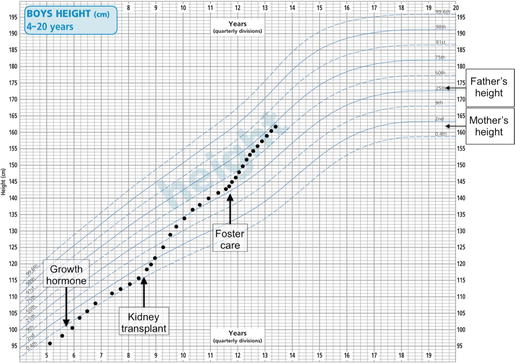, Mark Thomas1 and David Milford2
(1)
Department of Renal Medicine, Birmingham Heartlands Hospital, Birmingham, UK
(2)
Birmingham Children’s Hospital, Birmingham, UK
Abstract
In this chapter we explain:
How kidney disease affects children’s growth and development
The role of obesity in kidney disease
Growing Up with Kidney Disease
Chronic kidney disease has a major impact on children’s development and quality of life, particularly through its effects on growth. The lower a child’s kidney function, the slower will be their rate of growth. As a result, about a third of children with CKD fall below the third percentile for their age and gender. When kidney function is reduced in infancy the effect is even greater.
There is normally rapid growth in head circumference and brain volume during the first year of life. Poor growth is associated with intellectual impairment and learning difficulties. In older children, reduced growth and delayed puberty are associated with worse physical function and increased mortality. Short stature may lead to low self-esteem and emotional difficulties as children grow up to be adults.
An essential part of the care of any child, especially one with kidney disease, is the charting of height , weight and, for infants, head circumference (Patient 9.1).
Patient 9.1: Congenital Nephrotic Syndrome
Rayaan was born to consanguineous parents at term. An ultrasound scan at 20 weeks gestation had shown increased echogenicity of the kidneys. A repeat scan after birth confirmed them to be slightly large and echogenic. Kidney function was normal but serum albumin was low, 17 g/L. A urine dipstick test showed heavy proteinuria confirming congenital nephrotic syndrome (see Sect. “Congential nephrotic syndrome in page 84).
Over the next few days he became progressively more oedematous. He was given the ACE inhibitor captopril and NSAID indomethacin to reduce renal blood flow and urinary protein loss, and was supplemented with daily intravenous infusions of 20 % albumin.
Despite nasogastric feeding, his weight gain over the next three months was very slow and his head circumference barely increased (Fig. 9.1).


Fig. 9.1
Chart from a boy with congenital nephrotic syndrome showing delayed growth in head circumference, body length and body weight
To further reduce urinary protein loss, one of his kidneys was removed surgically.
Over the next four months his head circumference and then body weight increased rapidly. By 12 months of age, his weight and head circumference were between the 9th and 25th centile and his length was on the 0.4th centile.
Growth failure in kidney disease is mainly due to a functional deficiency of Insulin-like Growth Factor 1 (IGF-1) [1]. Although the serum level of growth hormone is disproportionally high, its stimulatory effect on IGF-1 production by the liver is reduced. Bioactive IGF-1 is reduced and inhibitory IGF binding proteins are increased. The severity of these abnormalities is proportional to the reduction in GFR. Treatment with pharmacological doses of recombinant growth hormone can overcome some of the functional deficiency of IGF-1 (Patient 9.2) .
Patient 9.2: Growth Retardation Due to Chronic Kidney Disease
Peter was born with dysplastic kidneys and reduced GFR. Despite nutritional supplements, calcium and vitamin D, his height remained below the 0.4th centile. Recombinant growth hormone injections were started and over the following three years his height velocity increased so that his height crossed the 0.4th centile (Fig. 9.2).


Fig. 9.2
Growth chart from a boy with chronic kidney disease showing the effects of growth hormone, kidney transplantation and improved social circumstances
His renal function continued to decline and at 8.5 years of age he received a live-related kidney transplant. Over the next 18 months his height velocity accelerated so that he crossed the 25th centile for height, consistent with the height of his father.
Stay updated, free articles. Join our Telegram channel

Full access? Get Clinical Tree








